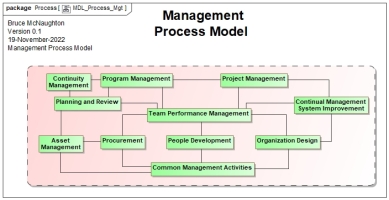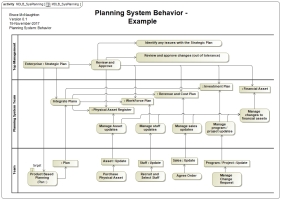Name: Planning System
Based on: Organization, Capability
The Planning System is a system created through a set of interacting capabilities realized throughout the set of organizations in an Enterprise.
The Organization Plan and Review design pattern provides an overview of the planning system across the organization.
Hoshin Kanri is an example of a whole organization planning system. Hoshin Kanri has been used by a number of major organizations to ensure all alignment of plans and actions.
See Plan Concepts
The purpose of the Planning System is to:
- Ensure there is a viable plan and budget to achieve the organizational objectives
- Each team understands their contribution to the organizational purpose and objectives
- Each individual has personal objectives aligned to the plan for the organization.
- Understand the physical and financial asset positions.
- Create forecasts based upon up to date and accurate information.
The Planning System is a dynamic system that balances the income and expenses for a team and / or management system. The Planning System consists of a set of capabilities that work together to form a planning system. These capabilities can then be distributed in various organizations or teams.
The Planning System includes the Strategic Plan as the context for all planning.
Systemic Measurable Variables
The desired results of the Planning System are:
- Positive Cash Flow with reserves
- Customer sales / revenue at the levels expected by the pricing model.
- Funding available for the team is sufficient to deliver the purpose.
- People forecasts by costs and skill mix
- Various models focusing on cost elements (tracking and monitoring).
Systemic Capabilities or Functions
The capabilities or functions the system provides.
- Manage financial assets
- Manage and forecast People and their costs
- Manage and forecast Physical assets and their costs
- Review and approve plans and take investment decisions.
- Manage and produce economic models for the enterprise
System States
The various defined states that the system-of-interestcan be in.
- Architectural states
- Identified: Planning System elements and owners identified.
- Defined: The Planning System objectives and measurements are defined.
- Transformational States
- Designed The Planning System Elements have been designed and reviewed.
- Approved: The Planning System has been approved for use.
- Operational States
- Managed:The Planning System is being managed and measured.
- Closing: The Planning System is closing
- Closed:The Planning System is no longer used.
Stakeholders and their concerns
Manager of the Team
- Do I understand the funding and expenses for my team?
- Is there any contingency included in the economic / funding forecasts?
- Is the financial forecast achievable?
- Is my team aligned to the Strategic Plan?
Product Manager / Business Manager
- Is our pricing model correct?
- Is our sales model viable given the pricing model?
- Are our transaction costs giving us a viable forecast?
- Do we have alternative suppliers in case there is an increase in demand?
- Will we achieve the financial targets established in the Strategic Plan?
Finance Manager
- Is our investment model correct?
- Is our supply / demand forecast based upon customer business plan inputs?
- Do we have sufficient capital and expense funding?
- Is our resource forecast / budget sufficient to meet our demand?
- Do we have sufficient asset / inventory forecasts to cover the business case?
- Are we in line with the Strategic Plan?
Manager of the Enterprise as a System of Systems (SoS)
- Will our product and service strategy deliver our objectives?
- Will our customers buy at the pricing and volumes forecast?
- Are there any changes on the horizon that will put our plans at risk?
- Is the Enterprise aligned to the Strategic Plan?
The following picture shows the context of the Planning System within the Enterprise as a System of Systems (SoS).
The Planning System provides support to planning, reporting, forecasting, etc. These may be sources external to the enterprise.
This system may also interact with local communities, and other economies. This system provides a dynamic way to look at the health of the enterprise or team depending upon the scope of the management system.
The Planning System consists of the following system elements (initial list):
The key conttext for these elements is the Strategic Plan.
The key system elements of the model are:
- Plan: providing a management commitment to deliver
- WorkForce Plan A full set of people (permanent / contractor) and key skills
- Asset Portfolio: A full set of physical assets owned / used / maintained
- Revenue and Cost Plan: a full set of benefits and costs delivered
- Investment Plan: A full set of investments to improve the capability of the enterprise.
- Financial Assets: A set of financial assets that are dynamically manged through updates.
- Team Capability: The activities to create, manage, update and release items in the Planning System.
The key processes underpinning the set of capabilities are:
Configuration / Scenario:
Describes any configuration / scenario attributes for a specific system-of-interest. This may not be appropriate for all system descriptions (e.g. patterns or abstract systems).
Cyclical (Repeating / Regular) Processes
Many of the elements of the Planning System are created through normal management processes using team capabilities. The overall effectiveness of the Planning System depends upon the implementation / realization of these capabilities.
The following picture highlights the sequencing of the elements and how they relate together.:
The relationships indicate that the Team Capabilities used and implemented within all of the teams is a critical element of having a fully functional Planning System.
Development Life Cycle Processes
Any of the elements of the Planning System are changed through the improvement of work product or process descriptions and associated activity descriptions and relationships. Audits and reviews will also provide information about the use and implementation of the team capabilities. This may lead to a set of changes necessary to improve the Planning System.
The following references support this type of system-of-interest.



